Quantitative Evaluation of a New Posturo-Locomotor Phenotype in a Rodent Model of Acute Unilateral Vestibulopathy
- PMID: 32582016
- PMCID: PMC7291375
- DOI: 10.3389/fneur.2020.00505
Quantitative Evaluation of a New Posturo-Locomotor Phenotype in a Rodent Model of Acute Unilateral Vestibulopathy
Erratum in
-
Corrigendum: Quantitative Evaluation of a New Posturo-Locomotor Phenotype in a Rodent Model of Acute Unilateral Vestibulopathy.Front Neurol. 2020 Oct 26;11:614242. doi: 10.3389/fneur.2020.614242. eCollection 2020. Front Neurol. 2020. PMID: 33193073 Free PMC article.
Abstract
Vestibular pathologies are difficult to diagnose. Existing devices make it possible to quantify and follow the evolution of posturo-locomotor symptoms following vestibular loss in static conditions. However, today, there are no diagnostic tools allowing the quantitative and spontaneous analysis of these symptoms in dynamic situations. With this in mind, we used an open-field video tracking test aiming at identifying specific posturo-locomotor markers in a rodent model of vestibular pathology. Using Ethovision XT 14 software (Noldus), we identified and quantified several behavioral parameters typical of unilateral vestibular lesions in a rat model of vestibular pathology. The unilateral vestibular neurectomy (UVN) rat model reproduces the symptoms of acute unilateral peripheral vestibulopathy in humans. Our data show deficits in locomotion velocity, distance traveled and animal mobility in the first day after the injury. We also highlighted alterations in several parameters, such as head and body acceleration, locomotor pattern, and position of the body, as well as "circling" behavior after vestibular loss. Here, we provide an enriched posturo-locomotor phenotype specific to full and irreversible unilateral vestibular loss. This test helps to strengthen the quantitative evaluation of vestibular disorders in unilateral vestibular lesion rat model. It may also be useful for testing pharmacological compounds promoting the restoration of balance. Transfer of these novel evaluation parameters to human pathology may improve the diagnosis of acute unilateral vestibulopathies and could better follow the evolution of the symptoms upon pharmacological and physical rehabilitation.
Keywords: behavior; ethovision; locomotor activity; posture; unilateral vestibular lesion; vestibular compensation; vestibular syndrome.
Copyright © 2020 Rastoldo, Marouane, El Mahmoudi, Péricat, Bourdet, Timon-David, Dumas, Chabbert and Tighilet.
Figures


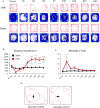
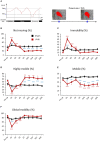
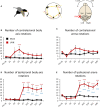
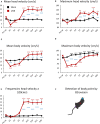
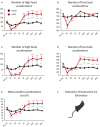
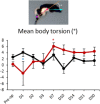
Similar articles
-
Identification of New Biomarkers of Posturo-Locomotor Instability in a Rodent Model of Vestibular Pathology.Front Neurol. 2020 May 29;11:470. doi: 10.3389/fneur.2020.00470. eCollection 2020. Front Neurol. 2020. PMID: 32547480 Free PMC article.
-
Corrigendum: Quantitative Evaluation of a New Posturo-Locomotor Phenotype in a Rodent Model of Acute Unilateral Vestibulopathy.Front Neurol. 2020 Oct 26;11:614242. doi: 10.3389/fneur.2020.614242. eCollection 2020. Front Neurol. 2020. PMID: 33193073 Free PMC article.
-
Effect of Fluoxetine and Acacetin on Central Vestibular Compensation in an Animal Model of Unilateral Peripheral Vestibulopathy.Biomedicines. 2022 Aug 27;10(9):2097. doi: 10.3390/biomedicines10092097. Biomedicines. 2022. PMID: 36140199 Free PMC article.
-
Acute Unilateral Vestibulopathy.Neurol Clin. 2015 Aug;33(3):669-85, x. doi: 10.1016/j.ncl.2015.04.012. Neurol Clin. 2015. PMID: 26231279 Review.
-
[Discovering a new functional neurogenic zone: the vestibular nuclei of the brainstem].Med Sci (Paris). 2011 Jun-Jul;27(6-7):605-13. doi: 10.1051/medsci/2011276012. Epub 2011 Jul 1. Med Sci (Paris). 2011. PMID: 21718644 Review. French.
Cited by
-
Breaking a dogma: acute anti-inflammatory treatment alters both post-lesional functional recovery and endogenous adaptive plasticity mechanisms in a rodent model of acute peripheral vestibulopathy.J Neuroinflammation. 2021 Aug 21;18(1):183. doi: 10.1186/s12974-021-02222-y. J Neuroinflammation. 2021. PMID: 34419105 Free PMC article.
-
Thyroid Axis and Vestibular Physiopathology: From Animal Model to Pathology.Int J Mol Sci. 2023 Jun 6;24(12):9826. doi: 10.3390/ijms24129826. Int J Mol Sci. 2023. PMID: 37372973 Free PMC article. Review.
-
Dose- and application route-dependent effects of betahistine on behavioral recovery and neuroplasticity after acute unilateral labyrinthectomy in rats.Front Neurol. 2023 Jul 19;14:1175481. doi: 10.3389/fneur.2023.1175481. eCollection 2023. Front Neurol. 2023. PMID: 37538257 Free PMC article.
-
Cellular and Molecular Mechanisms of Vestibular Ageing.J Clin Med. 2023 Aug 25;12(17):5519. doi: 10.3390/jcm12175519. J Clin Med. 2023. PMID: 37685587 Free PMC article. Review.
-
An open-source tool for automated human-level circling behavior detection.Sci Rep. 2024 Sep 8;14(1):20914. doi: 10.1038/s41598-024-71665-z. Sci Rep. 2024. PMID: 39245735 Free PMC article.
References
LinkOut - more resources
Full Text Sources
Other Literature Sources

